

![]()
![[A7V]](spz_1918.jpg) Kampfwagen A7V - 1917 |
![[Mk I - Female]](sgb19162.jpg) British Mk I - 1916 |
![]()
Once upon a time...there was Little Willie !!!
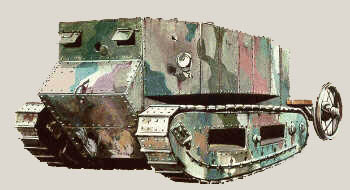
This "Thing", built in Lincoln by Foster and Company,
actually was an armored caisson with a false turret.It was equipped with Bullock
special tracks and with the Daimler-Foster tractor engine-clutch-transmission
system.
It was tested for the first time on September
6, 1915 and can be considered the first "true" tank.
Its features did not, however, comply with the British War Office requirements (e.g. it could not pass trenches wider than 5 feet) and,
therefore, poor Little Willie remained at a prototype stage!
The decision to design a new vehicle, capable of providing a better infantry support
than armored cars, faster but less effective on soft and muddy soil, was actually
imposed by the trench war in which the western front had been bogged down since the
early months of 1916.
The problem of crossing wide trenches, which had led Little Willie to its premature
end, was solved with the adoption of longer tracks and bigger driving wheels. This
solution gave to the first British armored vehicle, the Mark I, its peculiar
rhomboid shape.
The first order placed by the War Office was for 150 vehicles. For security reasons,
production was allocated to several different companies, each manufacturing single parts
to be assembled later. The workers who built the chassis nicknamed the new vehicle "tank"
because of its odd shape. (As to the origin of the "tank"
definition, other sources mention that this name was adopted because, again for security
purposes, the order which had been placed was for actually building tanks for the Russian
market).
Whichever the reason is, the nickname became the standard definition of the armored
vehicles!
This vehicle was called Male or Female
depending on its weaponry (guns and MG for the male version, machine guns only for
the female).
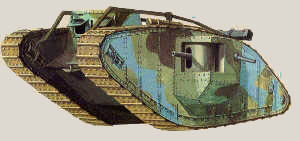 Mark IV - Male Weight : 28 ton Dimensions : 8.05 x 4.11 x 2.46 mt Armor (max) : 12 mm Range : 56 km Speed (max - route) : 6 km/hr Weapons : n.2 gun 57 mm + n.4 7.7 mm MG Crew : 8 |
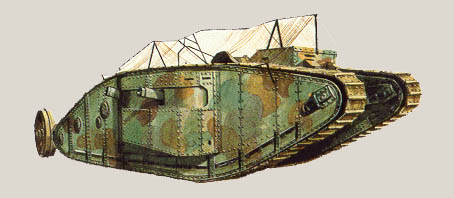 Mark I - Female Weight : 27 ton Dimensions : 8.05 x 4.37 x 2.45 mt Armor (max) : 12 mm Range : 37 km Speed (max - route) : 6 km/hr Weapons : n.5 7.7 mm MG Crew : 8 |
![]()
Between June 1915 and July 1918 the following tanks were produced :
| (type / units) | Mark I | Mark II | Mark III | Mark IV | Mark V |
| Male | 75 | 50 | 50 | 420 | 200 |
| Female | 75 | 0 | 0 | 595 | 200 |
![]()
Birth of the Armoured Warfare
The tanks saw their first action on September 15, 1916,
when the British Commander-in-Chief in France, Marshal
Haig, ordered the first two tank companies to be employed against the German
forces during the Battle of the Somme.
Albeit the modest results of this action, due to lack of trained crews, mechanical damages
and inexperience in tank field employement , the new weapon had, however, a highly
remarkable psychological impact.
At the same time the French were developing their own tanks (a little anecdote : the French attributed to J.L.Breton, a French engineer,
the invention of the new armored weapon; a special French-British committee was later
appointed to decide about tank's actual paternity.).
Forgetting these chauvinistic disputes, nobody can deny that French tanks'
"Father" was Col. J.E. Estienne. In spite of the military authorities' indifference and
skepticism about the new weapon, he obtained Gen. Joffre's (French Army
Commander-in-Chief) support and developed two types of tanks, both following the "assault
gun" concept :
 Schneider
M.16 C.A. |
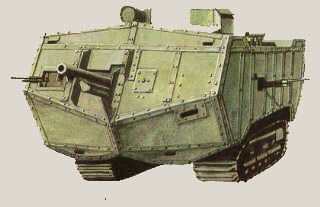 St.
Chamond M.16 |
![]()
The heavy French tanks saw their first action on April 16, 1917
during the Aisne offensive.
Due to mechanical defects and tactical inefficiences, the action was a complete failure
!!! Out of 121 tanks which set out from the assembly areas, 81 were lost - including 28
through breakdown, 17 through artillery hit alone, and 35 through fires occasioned by
artillery. A number of tanks caught fire without being hit at all. Twenty tanks were
retrieved. The final loss came to 76 tanks out of a grand total of 132 (57%).
Tank crews numbered 720 men, and 180 of them (25%) were dead, wounded or missing.
![]()
The above fiasco confirmed that Col. J.E. Estienne was right when, in
1916, had realized and accepted (sic!) that British heavy
tanks had better performance than the French ones. It was then decided to give impulse to
the mass production (*)of the new light tank : the Renault
F.T.17.
(*)From April 1917 to the end of the war, 3177 tanks were
delivered
. This tank, the first with a full 360 degree traverse turret, in spite of its thin
armour, low-power and limited fire capacity, gave a terrific contribution to final
victory. During the Soissons counteroffensive (July 1918)
they were used in mass attacks and, although a tremendous toll paid in terms of losses,
had great success.
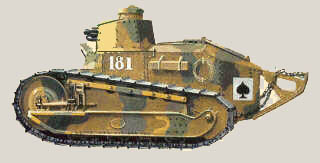 |
Renault F.T. 17 "char canon" (gun tank) Weight : 6.7 ton Dimensions : 4.88 x 1.74 x 2.14 mt Armor (max) : 22 mm Range : 60 km Speed (max - route) : 8 km/hr Weapons : n.1 gun 37 mm Crew : 2 |
Renault F.T. 17 "char mitrailleur" (machine gun tank) Weight : 6.7 ton Dimensions : 4.88 x 1.74 x 2.14 mt Armor (max) : 22 mm Range : 60 km Speed (max - route) : 8 km/hr Weapons : n.1 8.0mm MG Crew : 2 |
Over 2,500 were still around in 1940! The F.T. 17 can be, therefore, considered the oldest WWII tank!!
![]()
On the other side of the frontline, the Panzer implementation was late and definitely marginal. Only after the Battle of the Somme the Germans began to consider the need of developing armoured warfare.
The first German tank, the A7V, designed during the first months of 1917, was
produced by Daimler (mechanics), Steffens (chassis) and Noelle
(armour). The first tank was delivered in December 1917 and, by the end of the war, only
20 had been produced.
 |
A7V (Sturmpanzerwagen) Weight : 32 ton |
The Germans tried to fill the gap by using a certain number of enemy tanks captured at Cambrai (November 20, 1917) but, in spite of their efforts, they could not form more than 9 tank units (3 of A7V and 6 of captured Mark IV and Whippet) for a total of less than 100 tanks.
![]()
The A7V saw its first action at Saint Quentin (March 21, 1918). As a coincidence, on the same day (but on the other side of the front) another tank had its baptism of fire : the medium Whippet
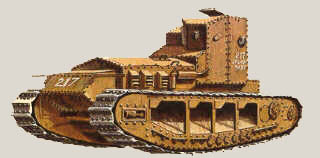 |
Whippet Medium Mark A Weight : 14 ton |
On April 24, 1918, at Villers-Bretonneux, the German and
the British tanks had their first clash in that which can be considered the first tank
versus tank combat in history .
The following is an excerpt of the chronicle of the event as reported by General H. Guderian in his "Achtung-Panzer !" (translated by Christopher Duffy ; edited by Arms and Armour"):
(Foreword : The 13 tanks which represented the entire German first line Panzerarme�, after having silenced several MG positions and cleared several hundred meters of British trenches are returning, in three groups, to their assembly areas).
"...At this juncture the second tank spotted three British tanks emerging from the southern tip of the wood of Arquenne - two females in the lead and a male IV following....
As soon as they left cover the two female Mark IVs spotted four German tanks and at once advanced to attack the nearest machine. The German tank immediately faced about and, taking advantage of some cover, opened fire. One of the British females was seen to be hit, and both machines gave up the attack. The third British tank, the male Mark IV, now materialized at two hundred meters from the German tank and scored several hits with a 57mm gun. Five of the crew were killed; the survivors abandoned the tank, though they were able to reoccupy it later and bring it back behind their own lines.
The commander of the male Mark IV (note : Lieut. Mitchell) lost contact with the other German tanks - in fact they had returned totheir assembly area, knowing nothing of the action that had just taken place. Shortly afterwards the British tank was knocked out by a direct hit.
A little later seven British Whippets pushed out from Cachy, evidently on reconnaissance. They caused considerable disorder and casualties among the German infantry, but they were detected by the third German tank under Lieutenant Bitter, who was in process of turning round, as we have seen. Bitter restored contact with the infantry and went over to the attack. He engaged the British tank on the far right at a range of 200 meters and set it on fire with the second round; he then fired at the tank 700 meters away on the far left and again set it ablaze with his second shot. Unfortunately the spring of his firing pin broke at this moment, but he opened fire with his machine-gun on the second British tank from the left and was able to knock it out. Surprisingly the remaining four Whippets meanwhile made an about turn and drove back to Cachy."
![]()
And now, if you want to skip 20 years ahead ... may I suggest a visit to my other tank pages, starting from A World of Tanks ?
![]()
![]() I'd be
delighted if you filled one page of my Guestbook
I'd be
delighted if you filled one page of my Guestbook
![]()
![]() Back to Klisura69
homepage
Back to Klisura69
homepage
Acknowledgment
All the color images (by G.Canestrari) have been selected from the "I Corazzati"
book by B.Benvenuti, edited by A.Mondadori - 1976). They are property of the authors
![]()
Page established on : February 25, 1997
Last update : March 24, 1998
This page is maintained by Mario Paesani .....the webmaster !
This page hosted by ![]() Get your own Free
Home Page
Get your own Free
Home Page